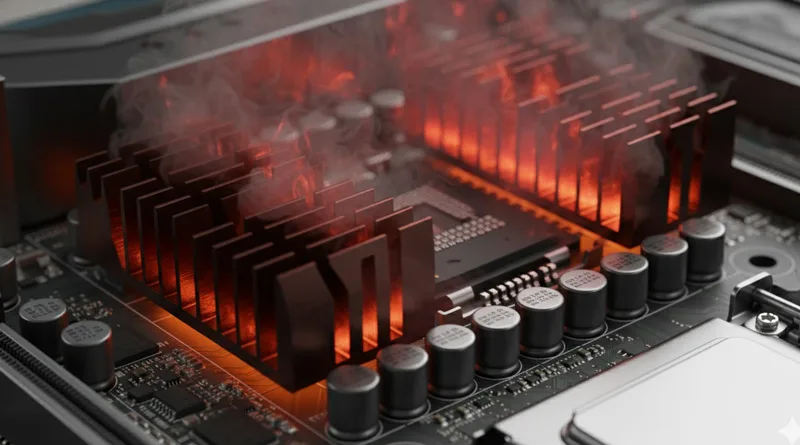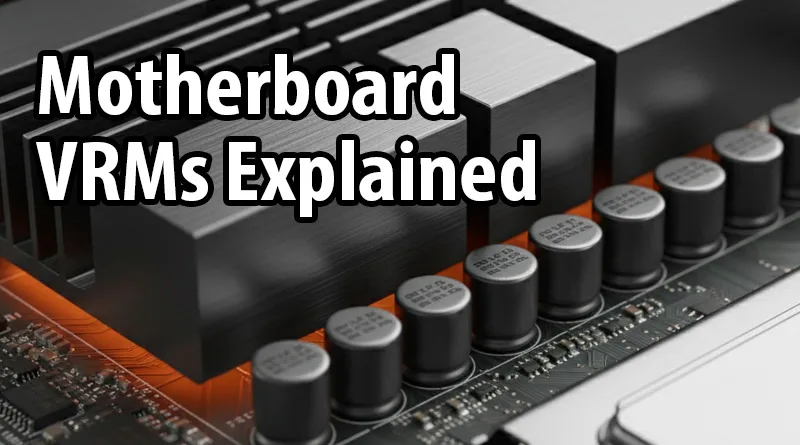In the world of PC building, the GPU and CPU get all the glory, but the unsung hero—or villain—of stability and performance is a small, often-overlooked circuit known as the VRM (Voltage Regulator Module). If you’ve ever wondered why your high-end CPU throttles under load or why your overclocking efforts fail, the answer almost always lies with the quality of your motherboard’s VRMs. Understanding this crucial component is essential, which is why we’ve put together this deep-dive on Motherboard VRMs Explained.
The function of the Motherboard VRMs Explained is to deliver a clean, stable, and precise amount of power to your CPU. Without a robust VRM, even the most expensive processor will be starved of power or destabilized when pushed. This guide will walk you through the science, the specs, and the most common pitfalls of Motherboard VRMs Explained. To see which specific high-quality boards you should consider, check out our definitive guide on choosing the Best Gaming Motherboard
What is a VRM? A Quick Guide to Motherboard VRMs Explained
The Motherboard VRMs Explained simply: they are the conversion centers that step down the 12-volt power coming from your power supply (PSU) to the extremely low voltage (typically 0.8V to 1.5V) required by your CPU. They also ensure this voltage is perfectly clean and stable.
The VRM’s Three Critical Functions
- Voltage Stepping: Converting 12V DC power to the sub-2V required by the CPU.
- Noise Filtering: Smoothing out any electrical “noise” or ripples to deliver a clean signal. A noisy signal causes instability (crashes).
- Dynamic Regulation: Instantly adjusting the power supply based on the CPU’s load (e.g., boosting instantly when a game starts, then dropping when idle).
The Direct Impact on Gaming Performance
A weak VRM system fails at all three of these functions under stress. When a powerful CPU (like an Intel i9 or Ryzen 9) boosts to its high clock speeds, it draws immense current. A weak VRM will:
- Throttle: Fail to deliver enough power, forcing the CPU to reduce its clock speed (throttling), which lowers your frame rates.
- Overheat: The VRM components themselves overheat, further throttling both the VRM and the CPU.
- Crash: Deliver noisy, unstable power, leading to system instability, blue screens, and failed overclocks.

Anatomy of a VRM: Phases, MOSFETs, and Inductors
To truly understand a VRM, you need to know its three main components. The quality of a VRM is measured by the quality of these components, not just the number of “phases.”
1. The Controller and Phases (The Delivery System)
A VRM system is organized into Phases. Each phase is an independent power delivery circuit. More phases generally means better power delivery, but more importantly, it means the workload is distributed.
- Benefit of More Phases: Spreading the electrical load across more phases means each component works less hard. This drastically reduces heat (the primary enemy of the VRM) and increases the lifespan of the VRM components, leading to a much more stable overclock.
- The Deception: Motherboard manufacturers often use doublers to make 6 real phases look like 12. Always look for real phase count or VRM tier lists, not just the advertised number.
2. MOSFETs (The Transistors)
The MOSFETs (Metal-Oxide-Semiconductor Field-Effect Transistors) are the active switching components that handle the high current.
- High-Quality: These are often integrated into a single Power Stage or DrMOS (Driver MOSFET) chip. These integrated chips are highly efficient, run cooler, and are much faster at switching, which is crucial for modern CPU demands.
- Low-Quality: Cheaper boards use discrete high-side and low-side MOSFETs, which are less efficient, run hotter, and take up more board space.
3. Capacitors and Inductors (The Filters)
The capacitors and inductors filter the current, smoothing out the voltage. High-quality components here are essential for ensuring the clean, stable power that prevents crashes during gaming.
VRM Heatsinks: Why Bigger is Better
The quality and size of the heatsinks mounted over the VRMs are almost as important as the VRM components themselves. They are passive coolers designed to wick heat away from the MOSFETs.
1. The Difference Between Dummies and Real Heatsinks
- Dummy Heatsinks: Cheaper boards sometimes use small, simple blocks of aluminum that are often not properly connected to the MOSFETs, doing little to dissipate heat.
- Real Heatsinks: High-end boards (like those in our Best Gaming Motherboard guide) use heavy, finned aluminum blocks, sometimes connected by a heat pipe, to maximize surface area. Some even have an active fan directly on the heatsink.
2. Thermal Pads: The Bridge
Underneath the heatsink is a thermal pad. A good heatsink means nothing if the thermal pad is poor. Always check reviews to ensure the thermal pad is making full, solid contact with the MOSFETs.
Overclocking and VRM Quality: The Ultimate Test
If you plan to overclock your CPU, the VRM is your absolute bottleneck. A CPU with an unlocked multiplier (Intel ‘K’ series or all AMD Ryzens) is designed to draw more power than its stock rating when overclocked.
The Overclocking Threshold
- Low-Tier VRM: Cannot sustain any significant overclock. It will immediately overheat and throttle, preventing you from ever seeing the benefit.
- Mid-Tier VRM: Can handle a moderate all-core overclock but will still run hot and may require active airflow from a case fan. This is sufficient for most users who want a slight boost.
- High-Tier VRM: Required for extreme all-core overclocks and necessary for safely pushing a top-tier CPU (like an i9-14900K) to its thermal and power limits.
For serious overclocking, always consult enthusiast-created VRM Tier Lists online to confirm the true power delivery capability of any board you are considering. The VRM is literally the limiting factor in how fast your CPU can go.
Conclusion: Motherboard VRMs Explained for Smart Buyers
No matter how powerful your CPU is, its performance is directly dependent on the motherboard’s VRM quality. You cannot skimp on this component and expect stable, high-performance gaming. This knowledge, gained from having Motherboard VRMs Explained, is your secret weapon.
When shopping for your new foundation, be skeptical of large phase numbers and prioritize boards with high-quality, integrated Power Stages (DrMOS) and robust, heavy heatsinks. A quality VRM ensures zero throttling and provides the stable power required for a successful and long-lasting overclock. This knowledge is the secret to building a high-end PC that actually performs like one.
For a list of motherboards that feature only the highest quality, tested VRM systems, refer to our definitive guide on choosing the Best Gaming Motherboard.

